The Role of Business Ethics in Understanding SMRT's Cultural Issues
VerifiedAdded on 2023/06/16
|11
|3183
|261
Essay
AI Summary
This essay critically examines the extent to which business ethics concepts, such as ethical culture, ethical leadership, and ethical climate, explain the 'systemic cultural issues' at SMRT. It argues that a lack of ethics within SMRT stems from poor planning, systematic failures, and inadequate monitoring of employees. The essay discusses the 'bad apple and bad barrel' theory, suggesting that SMRT's problems may be rooted in a negative corporate culture and a lack of moral leadership. The resignation of SMRT's CEO due to persistent breakdowns highlights these deep-seated cultural issues. The essay concludes by emphasizing the need for ethical leaders with strong moral characteristics and the importance of integrating ethical codes into the organization's culture to foster a more ethical and effective environment.
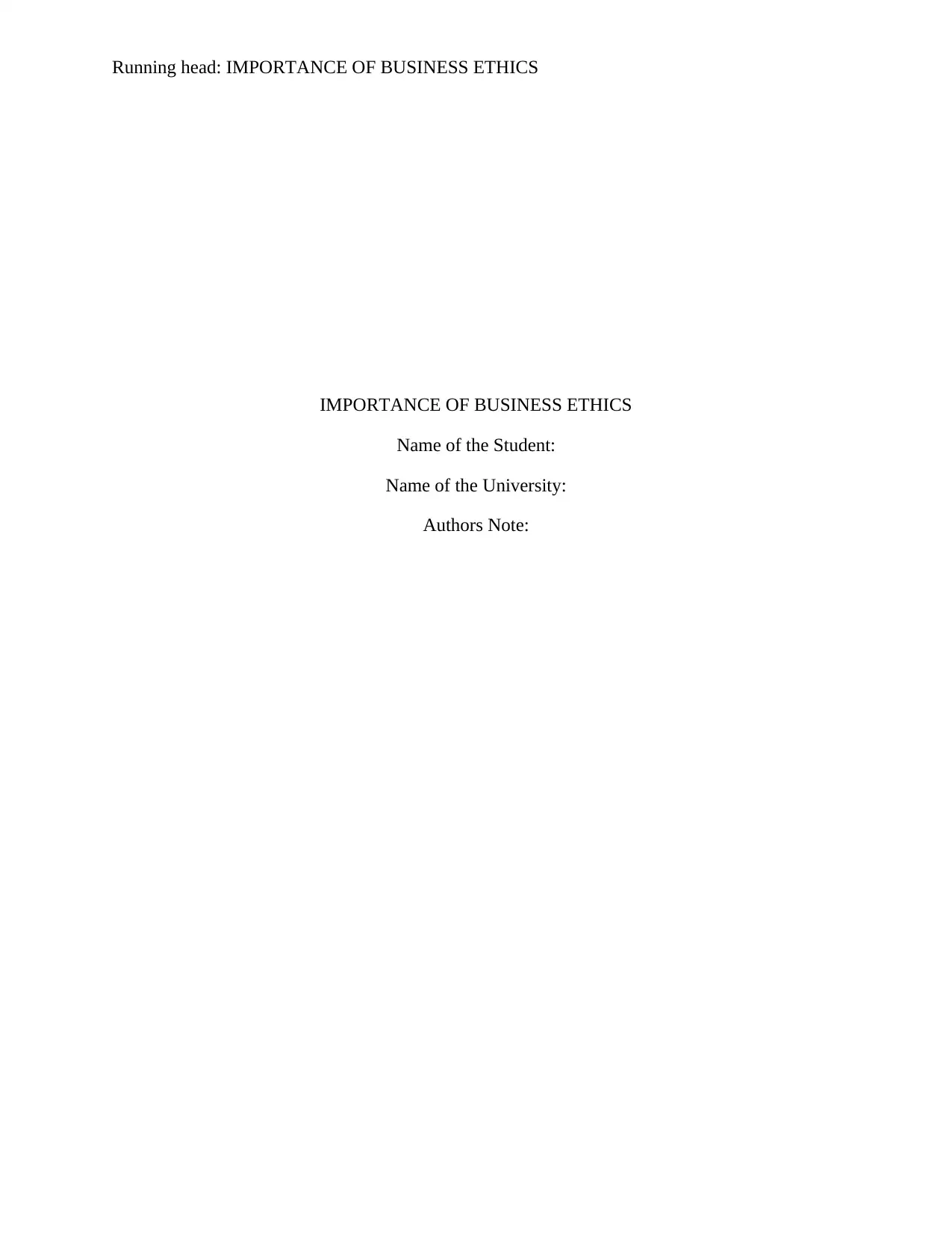
Running head: IMPORTANCE OF BUSINESS ETHICS
IMPORTANCE OF BUSINESS ETHICS
Name of the Student:
Name of the University:
Authors Note:
IMPORTANCE OF BUSINESS ETHICS
Name of the Student:
Name of the University:
Authors Note:
Paraphrase This Document
Need a fresh take? Get an instant paraphrase of this document with our AI Paraphraser
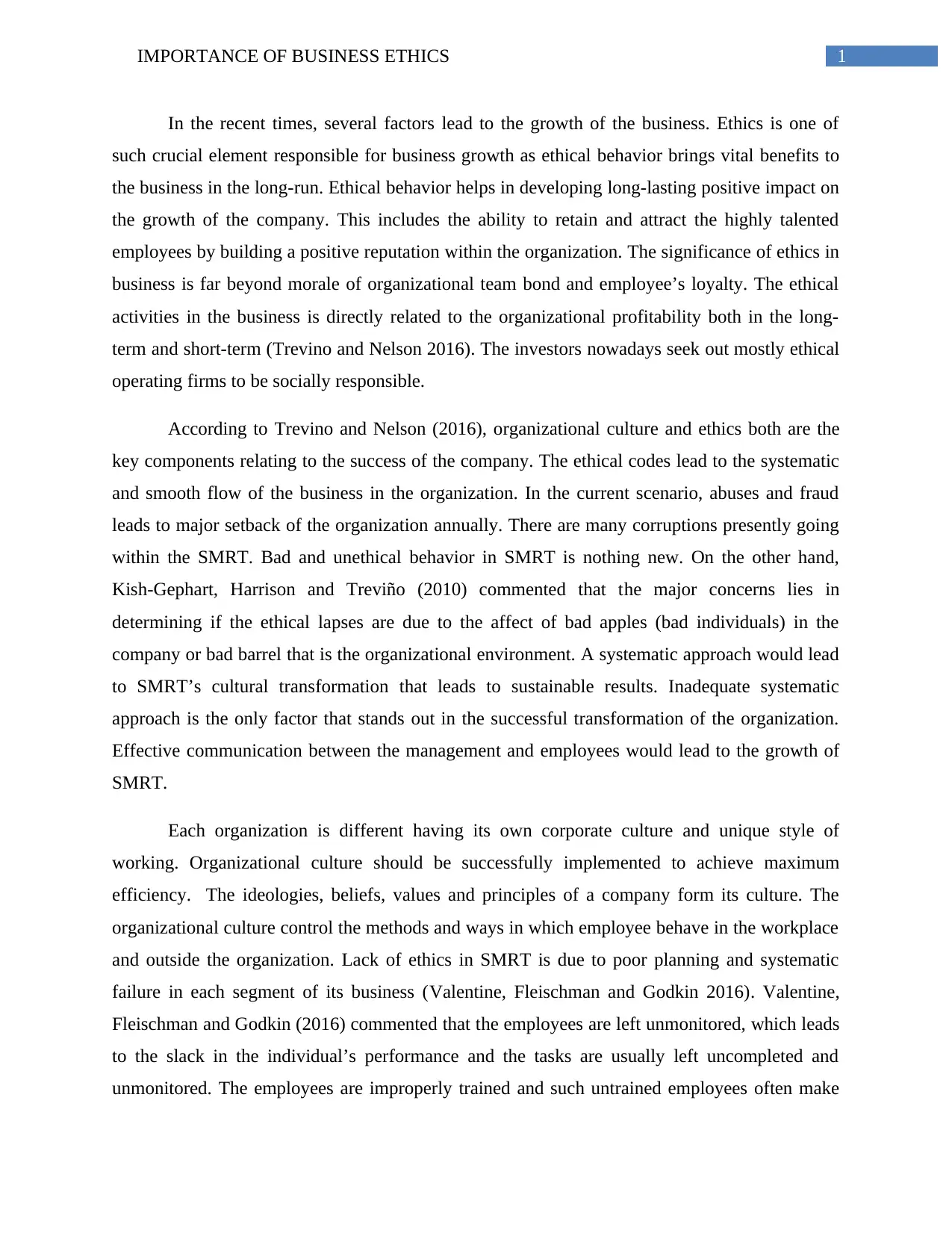
1IMPORTANCE OF BUSINESS ETHICS
In the recent times, several factors lead to the growth of the business. Ethics is one of
such crucial element responsible for business growth as ethical behavior brings vital benefits to
the business in the long-run. Ethical behavior helps in developing long-lasting positive impact on
the growth of the company. This includes the ability to retain and attract the highly talented
employees by building a positive reputation within the organization. The significance of ethics in
business is far beyond morale of organizational team bond and employee’s loyalty. The ethical
activities in the business is directly related to the organizational profitability both in the long-
term and short-term (Trevino and Nelson 2016). The investors nowadays seek out mostly ethical
operating firms to be socially responsible.
According to Trevino and Nelson (2016), organizational culture and ethics both are the
key components relating to the success of the company. The ethical codes lead to the systematic
and smooth flow of the business in the organization. In the current scenario, abuses and fraud
leads to major setback of the organization annually. There are many corruptions presently going
within the SMRT. Bad and unethical behavior in SMRT is nothing new. On the other hand,
Kish-Gephart, Harrison and Treviño (2010) commented that the major concerns lies in
determining if the ethical lapses are due to the affect of bad apples (bad individuals) in the
company or bad barrel that is the organizational environment. A systematic approach would lead
to SMRT’s cultural transformation that leads to sustainable results. Inadequate systematic
approach is the only factor that stands out in the successful transformation of the organization.
Effective communication between the management and employees would lead to the growth of
SMRT.
Each organization is different having its own corporate culture and unique style of
working. Organizational culture should be successfully implemented to achieve maximum
efficiency. The ideologies, beliefs, values and principles of a company form its culture. The
organizational culture control the methods and ways in which employee behave in the workplace
and outside the organization. Lack of ethics in SMRT is due to poor planning and systematic
failure in each segment of its business (Valentine, Fleischman and Godkin 2016). Valentine,
Fleischman and Godkin (2016) commented that the employees are left unmonitored, which leads
to the slack in the individual’s performance and the tasks are usually left uncompleted and
unmonitored. The employees are improperly trained and such untrained employees often make
In the recent times, several factors lead to the growth of the business. Ethics is one of
such crucial element responsible for business growth as ethical behavior brings vital benefits to
the business in the long-run. Ethical behavior helps in developing long-lasting positive impact on
the growth of the company. This includes the ability to retain and attract the highly talented
employees by building a positive reputation within the organization. The significance of ethics in
business is far beyond morale of organizational team bond and employee’s loyalty. The ethical
activities in the business is directly related to the organizational profitability both in the long-
term and short-term (Trevino and Nelson 2016). The investors nowadays seek out mostly ethical
operating firms to be socially responsible.
According to Trevino and Nelson (2016), organizational culture and ethics both are the
key components relating to the success of the company. The ethical codes lead to the systematic
and smooth flow of the business in the organization. In the current scenario, abuses and fraud
leads to major setback of the organization annually. There are many corruptions presently going
within the SMRT. Bad and unethical behavior in SMRT is nothing new. On the other hand,
Kish-Gephart, Harrison and Treviño (2010) commented that the major concerns lies in
determining if the ethical lapses are due to the affect of bad apples (bad individuals) in the
company or bad barrel that is the organizational environment. A systematic approach would lead
to SMRT’s cultural transformation that leads to sustainable results. Inadequate systematic
approach is the only factor that stands out in the successful transformation of the organization.
Effective communication between the management and employees would lead to the growth of
SMRT.
Each organization is different having its own corporate culture and unique style of
working. Organizational culture should be successfully implemented to achieve maximum
efficiency. The ideologies, beliefs, values and principles of a company form its culture. The
organizational culture control the methods and ways in which employee behave in the workplace
and outside the organization. Lack of ethics in SMRT is due to poor planning and systematic
failure in each segment of its business (Valentine, Fleischman and Godkin 2016). Valentine,
Fleischman and Godkin (2016) commented that the employees are left unmonitored, which leads
to the slack in the individual’s performance and the tasks are usually left uncompleted and
unmonitored. The employees are improperly trained and such untrained employees often make
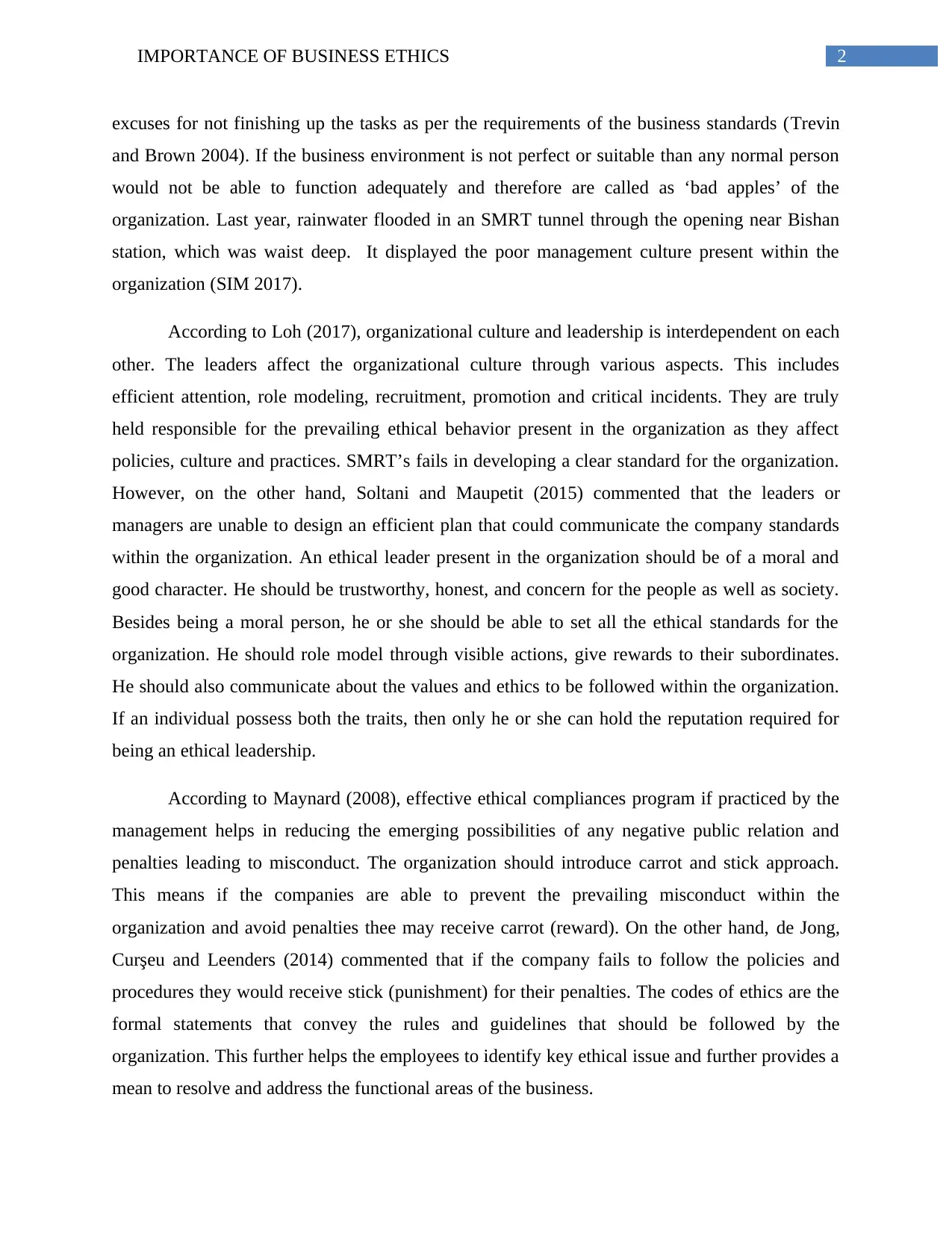
2IMPORTANCE OF BUSINESS ETHICS
excuses for not finishing up the tasks as per the requirements of the business standards (Trevin
and Brown 2004). If the business environment is not perfect or suitable than any normal person
would not be able to function adequately and therefore are called as ‘bad apples’ of the
organization. Last year, rainwater flooded in an SMRT tunnel through the opening near Bishan
station, which was waist deep. It displayed the poor management culture present within the
organization (SIM 2017).
According to Loh (2017), organizational culture and leadership is interdependent on each
other. The leaders affect the organizational culture through various aspects. This includes
efficient attention, role modeling, recruitment, promotion and critical incidents. They are truly
held responsible for the prevailing ethical behavior present in the organization as they affect
policies, culture and practices. SMRT’s fails in developing a clear standard for the organization.
However, on the other hand, Soltani and Maupetit (2015) commented that the leaders or
managers are unable to design an efficient plan that could communicate the company standards
within the organization. An ethical leader present in the organization should be of a moral and
good character. He should be trustworthy, honest, and concern for the people as well as society.
Besides being a moral person, he or she should be able to set all the ethical standards for the
organization. He should role model through visible actions, give rewards to their subordinates.
He should also communicate about the values and ethics to be followed within the organization.
If an individual possess both the traits, then only he or she can hold the reputation required for
being an ethical leadership.
According to Maynard (2008), effective ethical compliances program if practiced by the
management helps in reducing the emerging possibilities of any negative public relation and
penalties leading to misconduct. The organization should introduce carrot and stick approach.
This means if the companies are able to prevent the prevailing misconduct within the
organization and avoid penalties thee may receive carrot (reward). On the other hand, de Jong,
Curşeu and Leenders (2014) commented that if the company fails to follow the policies and
procedures they would receive stick (punishment) for their penalties. The codes of ethics are the
formal statements that convey the rules and guidelines that should be followed by the
organization. This further helps the employees to identify key ethical issue and further provides a
mean to resolve and address the functional areas of the business.
excuses for not finishing up the tasks as per the requirements of the business standards (Trevin
and Brown 2004). If the business environment is not perfect or suitable than any normal person
would not be able to function adequately and therefore are called as ‘bad apples’ of the
organization. Last year, rainwater flooded in an SMRT tunnel through the opening near Bishan
station, which was waist deep. It displayed the poor management culture present within the
organization (SIM 2017).
According to Loh (2017), organizational culture and leadership is interdependent on each
other. The leaders affect the organizational culture through various aspects. This includes
efficient attention, role modeling, recruitment, promotion and critical incidents. They are truly
held responsible for the prevailing ethical behavior present in the organization as they affect
policies, culture and practices. SMRT’s fails in developing a clear standard for the organization.
However, on the other hand, Soltani and Maupetit (2015) commented that the leaders or
managers are unable to design an efficient plan that could communicate the company standards
within the organization. An ethical leader present in the organization should be of a moral and
good character. He should be trustworthy, honest, and concern for the people as well as society.
Besides being a moral person, he or she should be able to set all the ethical standards for the
organization. He should role model through visible actions, give rewards to their subordinates.
He should also communicate about the values and ethics to be followed within the organization.
If an individual possess both the traits, then only he or she can hold the reputation required for
being an ethical leadership.
According to Maynard (2008), effective ethical compliances program if practiced by the
management helps in reducing the emerging possibilities of any negative public relation and
penalties leading to misconduct. The organization should introduce carrot and stick approach.
This means if the companies are able to prevent the prevailing misconduct within the
organization and avoid penalties thee may receive carrot (reward). On the other hand, de Jong,
Curşeu and Leenders (2014) commented that if the company fails to follow the policies and
procedures they would receive stick (punishment) for their penalties. The codes of ethics are the
formal statements that convey the rules and guidelines that should be followed by the
organization. This further helps the employees to identify key ethical issue and further provides a
mean to resolve and address the functional areas of the business.
⊘ This is a preview!⊘
Do you want full access?
Subscribe today to unlock all pages.

Trusted by 1+ million students worldwide
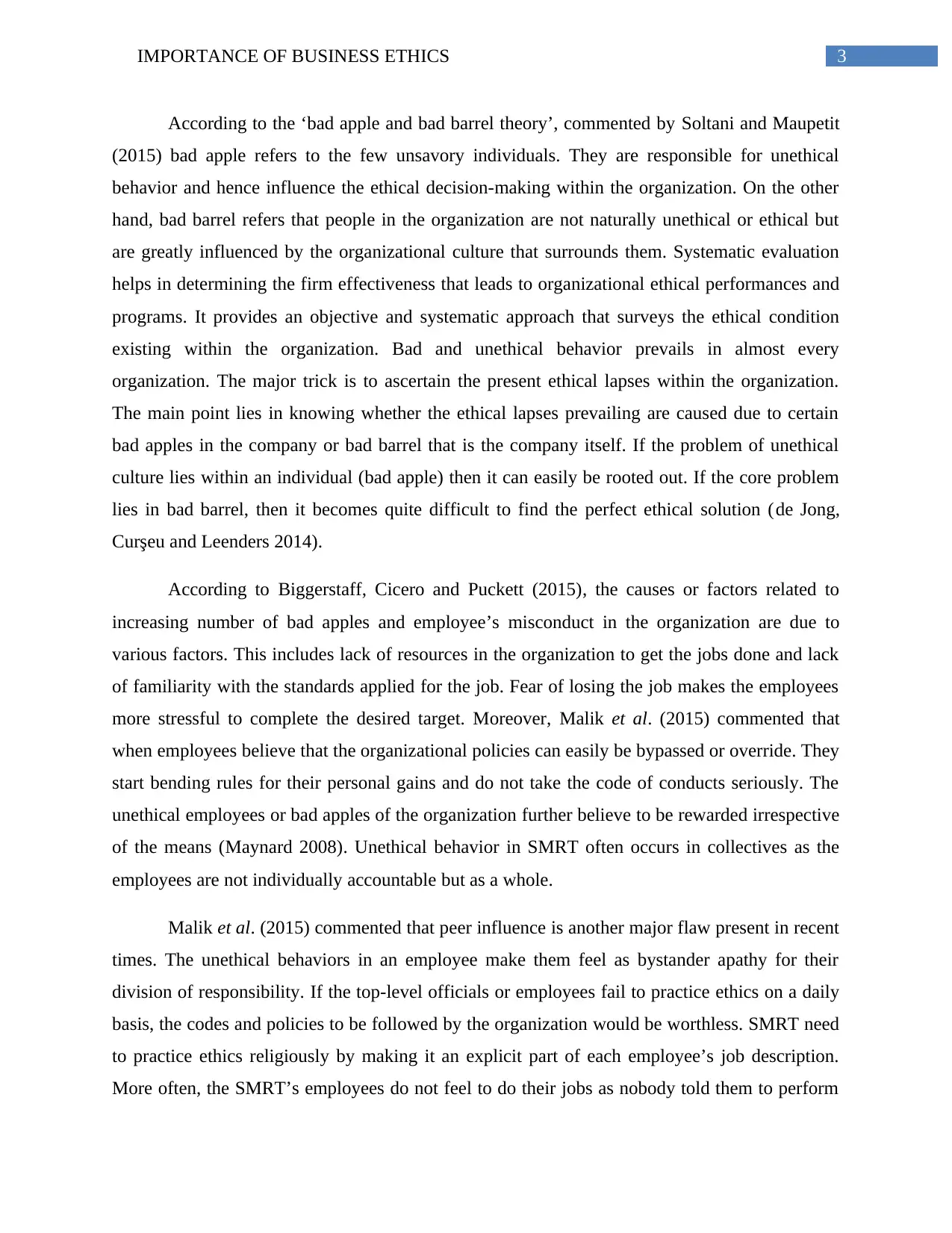
3IMPORTANCE OF BUSINESS ETHICS
According to the ‘bad apple and bad barrel theory’, commented by Soltani and Maupetit
(2015) bad apple refers to the few unsavory individuals. They are responsible for unethical
behavior and hence influence the ethical decision-making within the organization. On the other
hand, bad barrel refers that people in the organization are not naturally unethical or ethical but
are greatly influenced by the organizational culture that surrounds them. Systematic evaluation
helps in determining the firm effectiveness that leads to organizational ethical performances and
programs. It provides an objective and systematic approach that surveys the ethical condition
existing within the organization. Bad and unethical behavior prevails in almost every
organization. The major trick is to ascertain the present ethical lapses within the organization.
The main point lies in knowing whether the ethical lapses prevailing are caused due to certain
bad apples in the company or bad barrel that is the company itself. If the problem of unethical
culture lies within an individual (bad apple) then it can easily be rooted out. If the core problem
lies in bad barrel, then it becomes quite difficult to find the perfect ethical solution (de Jong,
Curşeu and Leenders 2014).
According to Biggerstaff, Cicero and Puckett (2015), the causes or factors related to
increasing number of bad apples and employee’s misconduct in the organization are due to
various factors. This includes lack of resources in the organization to get the jobs done and lack
of familiarity with the standards applied for the job. Fear of losing the job makes the employees
more stressful to complete the desired target. Moreover, Malik et al. (2015) commented that
when employees believe that the organizational policies can easily be bypassed or override. They
start bending rules for their personal gains and do not take the code of conducts seriously. The
unethical employees or bad apples of the organization further believe to be rewarded irrespective
of the means (Maynard 2008). Unethical behavior in SMRT often occurs in collectives as the
employees are not individually accountable but as a whole.
Malik et al. (2015) commented that peer influence is another major flaw present in recent
times. The unethical behaviors in an employee make them feel as bystander apathy for their
division of responsibility. If the top-level officials or employees fail to practice ethics on a daily
basis, the codes and policies to be followed by the organization would be worthless. SMRT need
to practice ethics religiously by making it an explicit part of each employee’s job description.
More often, the SMRT’s employees do not feel to do their jobs as nobody told them to perform
According to the ‘bad apple and bad barrel theory’, commented by Soltani and Maupetit
(2015) bad apple refers to the few unsavory individuals. They are responsible for unethical
behavior and hence influence the ethical decision-making within the organization. On the other
hand, bad barrel refers that people in the organization are not naturally unethical or ethical but
are greatly influenced by the organizational culture that surrounds them. Systematic evaluation
helps in determining the firm effectiveness that leads to organizational ethical performances and
programs. It provides an objective and systematic approach that surveys the ethical condition
existing within the organization. Bad and unethical behavior prevails in almost every
organization. The major trick is to ascertain the present ethical lapses within the organization.
The main point lies in knowing whether the ethical lapses prevailing are caused due to certain
bad apples in the company or bad barrel that is the company itself. If the problem of unethical
culture lies within an individual (bad apple) then it can easily be rooted out. If the core problem
lies in bad barrel, then it becomes quite difficult to find the perfect ethical solution (de Jong,
Curşeu and Leenders 2014).
According to Biggerstaff, Cicero and Puckett (2015), the causes or factors related to
increasing number of bad apples and employee’s misconduct in the organization are due to
various factors. This includes lack of resources in the organization to get the jobs done and lack
of familiarity with the standards applied for the job. Fear of losing the job makes the employees
more stressful to complete the desired target. Moreover, Malik et al. (2015) commented that
when employees believe that the organizational policies can easily be bypassed or override. They
start bending rules for their personal gains and do not take the code of conducts seriously. The
unethical employees or bad apples of the organization further believe to be rewarded irrespective
of the means (Maynard 2008). Unethical behavior in SMRT often occurs in collectives as the
employees are not individually accountable but as a whole.
Malik et al. (2015) commented that peer influence is another major flaw present in recent
times. The unethical behaviors in an employee make them feel as bystander apathy for their
division of responsibility. If the top-level officials or employees fail to practice ethics on a daily
basis, the codes and policies to be followed by the organization would be worthless. SMRT need
to practice ethics religiously by making it an explicit part of each employee’s job description.
More often, the SMRT’s employees do not feel to do their jobs as nobody told them to perform
Paraphrase This Document
Need a fresh take? Get an instant paraphrase of this document with our AI Paraphraser
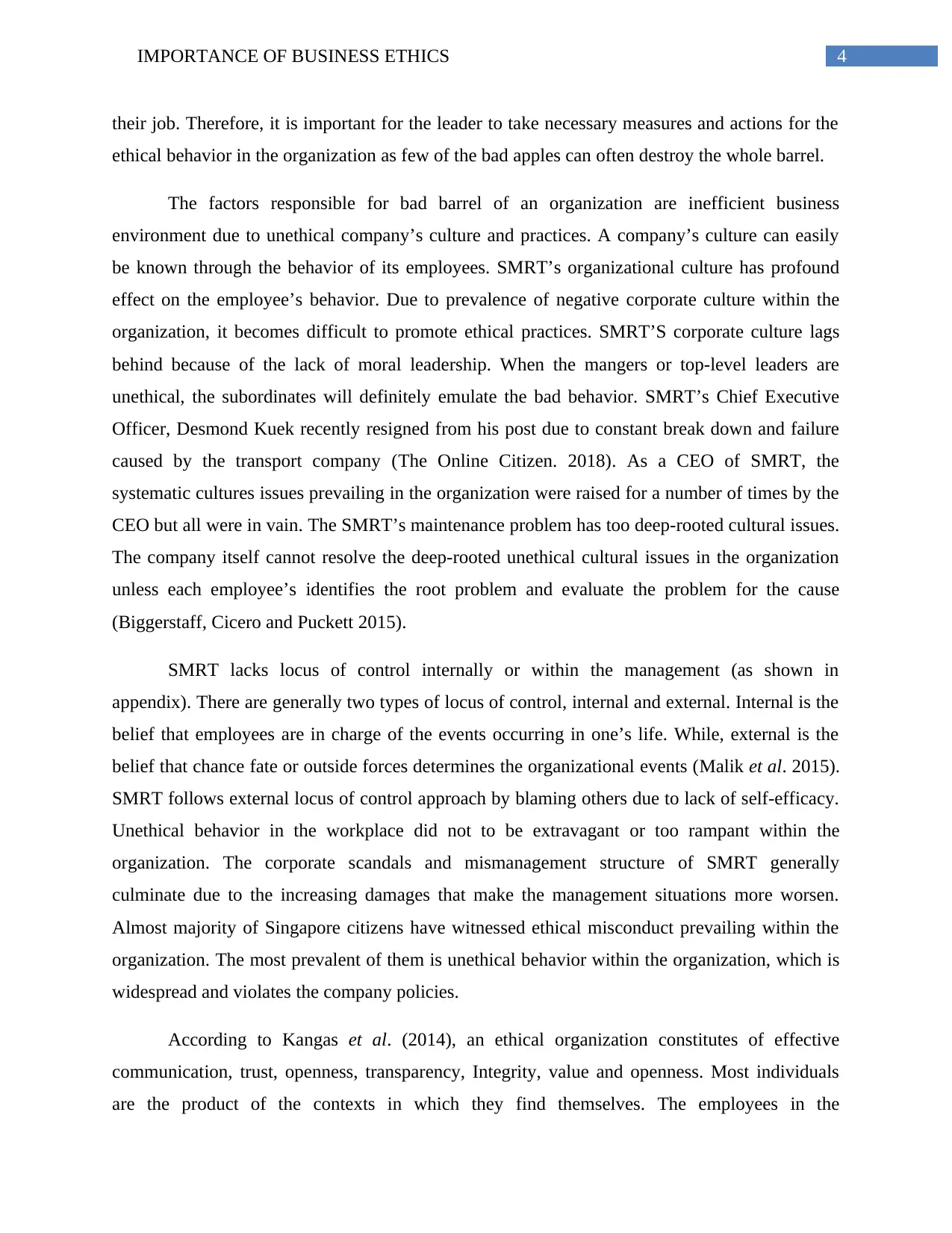
4IMPORTANCE OF BUSINESS ETHICS
their job. Therefore, it is important for the leader to take necessary measures and actions for the
ethical behavior in the organization as few of the bad apples can often destroy the whole barrel.
The factors responsible for bad barrel of an organization are inefficient business
environment due to unethical company’s culture and practices. A company’s culture can easily
be known through the behavior of its employees. SMRT’s organizational culture has profound
effect on the employee’s behavior. Due to prevalence of negative corporate culture within the
organization, it becomes difficult to promote ethical practices. SMRT’S corporate culture lags
behind because of the lack of moral leadership. When the mangers or top-level leaders are
unethical, the subordinates will definitely emulate the bad behavior. SMRT’s Chief Executive
Officer, Desmond Kuek recently resigned from his post due to constant break down and failure
caused by the transport company (The Online Citizen. 2018). As a CEO of SMRT, the
systematic cultures issues prevailing in the organization were raised for a number of times by the
CEO but all were in vain. The SMRT’s maintenance problem has too deep-rooted cultural issues.
The company itself cannot resolve the deep-rooted unethical cultural issues in the organization
unless each employee’s identifies the root problem and evaluate the problem for the cause
(Biggerstaff, Cicero and Puckett 2015).
SMRT lacks locus of control internally or within the management (as shown in
appendix). There are generally two types of locus of control, internal and external. Internal is the
belief that employees are in charge of the events occurring in one’s life. While, external is the
belief that chance fate or outside forces determines the organizational events (Malik et al. 2015).
SMRT follows external locus of control approach by blaming others due to lack of self-efficacy.
Unethical behavior in the workplace did not to be extravagant or too rampant within the
organization. The corporate scandals and mismanagement structure of SMRT generally
culminate due to the increasing damages that make the management situations more worsen.
Almost majority of Singapore citizens have witnessed ethical misconduct prevailing within the
organization. The most prevalent of them is unethical behavior within the organization, which is
widespread and violates the company policies.
According to Kangas et al. (2014), an ethical organization constitutes of effective
communication, trust, openness, transparency, Integrity, value and openness. Most individuals
are the product of the contexts in which they find themselves. The employees in the
their job. Therefore, it is important for the leader to take necessary measures and actions for the
ethical behavior in the organization as few of the bad apples can often destroy the whole barrel.
The factors responsible for bad barrel of an organization are inefficient business
environment due to unethical company’s culture and practices. A company’s culture can easily
be known through the behavior of its employees. SMRT’s organizational culture has profound
effect on the employee’s behavior. Due to prevalence of negative corporate culture within the
organization, it becomes difficult to promote ethical practices. SMRT’S corporate culture lags
behind because of the lack of moral leadership. When the mangers or top-level leaders are
unethical, the subordinates will definitely emulate the bad behavior. SMRT’s Chief Executive
Officer, Desmond Kuek recently resigned from his post due to constant break down and failure
caused by the transport company (The Online Citizen. 2018). As a CEO of SMRT, the
systematic cultures issues prevailing in the organization were raised for a number of times by the
CEO but all were in vain. The SMRT’s maintenance problem has too deep-rooted cultural issues.
The company itself cannot resolve the deep-rooted unethical cultural issues in the organization
unless each employee’s identifies the root problem and evaluate the problem for the cause
(Biggerstaff, Cicero and Puckett 2015).
SMRT lacks locus of control internally or within the management (as shown in
appendix). There are generally two types of locus of control, internal and external. Internal is the
belief that employees are in charge of the events occurring in one’s life. While, external is the
belief that chance fate or outside forces determines the organizational events (Malik et al. 2015).
SMRT follows external locus of control approach by blaming others due to lack of self-efficacy.
Unethical behavior in the workplace did not to be extravagant or too rampant within the
organization. The corporate scandals and mismanagement structure of SMRT generally
culminate due to the increasing damages that make the management situations more worsen.
Almost majority of Singapore citizens have witnessed ethical misconduct prevailing within the
organization. The most prevalent of them is unethical behavior within the organization, which is
widespread and violates the company policies.
According to Kangas et al. (2014), an ethical organization constitutes of effective
communication, trust, openness, transparency, Integrity, value and openness. Most individuals
are the product of the contexts in which they find themselves. The employees in the
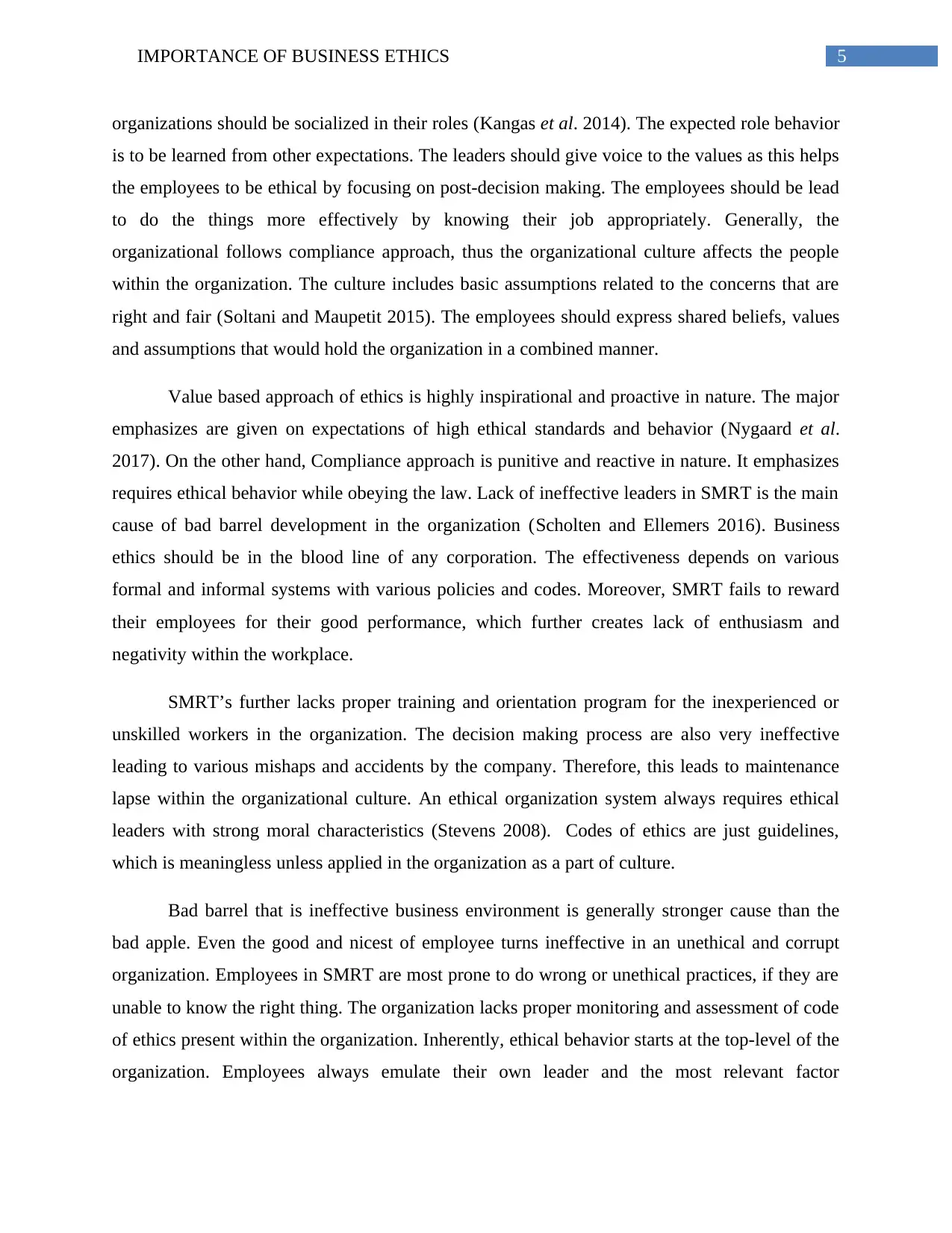
5IMPORTANCE OF BUSINESS ETHICS
organizations should be socialized in their roles (Kangas et al. 2014). The expected role behavior
is to be learned from other expectations. The leaders should give voice to the values as this helps
the employees to be ethical by focusing on post-decision making. The employees should be lead
to do the things more effectively by knowing their job appropriately. Generally, the
organizational follows compliance approach, thus the organizational culture affects the people
within the organization. The culture includes basic assumptions related to the concerns that are
right and fair (Soltani and Maupetit 2015). The employees should express shared beliefs, values
and assumptions that would hold the organization in a combined manner.
Value based approach of ethics is highly inspirational and proactive in nature. The major
emphasizes are given on expectations of high ethical standards and behavior (Nygaard et al.
2017). On the other hand, Compliance approach is punitive and reactive in nature. It emphasizes
requires ethical behavior while obeying the law. Lack of ineffective leaders in SMRT is the main
cause of bad barrel development in the organization (Scholten and Ellemers 2016). Business
ethics should be in the blood line of any corporation. The effectiveness depends on various
formal and informal systems with various policies and codes. Moreover, SMRT fails to reward
their employees for their good performance, which further creates lack of enthusiasm and
negativity within the workplace.
SMRT’s further lacks proper training and orientation program for the inexperienced or
unskilled workers in the organization. The decision making process are also very ineffective
leading to various mishaps and accidents by the company. Therefore, this leads to maintenance
lapse within the organizational culture. An ethical organization system always requires ethical
leaders with strong moral characteristics (Stevens 2008). Codes of ethics are just guidelines,
which is meaningless unless applied in the organization as a part of culture.
Bad barrel that is ineffective business environment is generally stronger cause than the
bad apple. Even the good and nicest of employee turns ineffective in an unethical and corrupt
organization. Employees in SMRT are most prone to do wrong or unethical practices, if they are
unable to know the right thing. The organization lacks proper monitoring and assessment of code
of ethics present within the organization. Inherently, ethical behavior starts at the top-level of the
organization. Employees always emulate their own leader and the most relevant factor
organizations should be socialized in their roles (Kangas et al. 2014). The expected role behavior
is to be learned from other expectations. The leaders should give voice to the values as this helps
the employees to be ethical by focusing on post-decision making. The employees should be lead
to do the things more effectively by knowing their job appropriately. Generally, the
organizational follows compliance approach, thus the organizational culture affects the people
within the organization. The culture includes basic assumptions related to the concerns that are
right and fair (Soltani and Maupetit 2015). The employees should express shared beliefs, values
and assumptions that would hold the organization in a combined manner.
Value based approach of ethics is highly inspirational and proactive in nature. The major
emphasizes are given on expectations of high ethical standards and behavior (Nygaard et al.
2017). On the other hand, Compliance approach is punitive and reactive in nature. It emphasizes
requires ethical behavior while obeying the law. Lack of ineffective leaders in SMRT is the main
cause of bad barrel development in the organization (Scholten and Ellemers 2016). Business
ethics should be in the blood line of any corporation. The effectiveness depends on various
formal and informal systems with various policies and codes. Moreover, SMRT fails to reward
their employees for their good performance, which further creates lack of enthusiasm and
negativity within the workplace.
SMRT’s further lacks proper training and orientation program for the inexperienced or
unskilled workers in the organization. The decision making process are also very ineffective
leading to various mishaps and accidents by the company. Therefore, this leads to maintenance
lapse within the organizational culture. An ethical organization system always requires ethical
leaders with strong moral characteristics (Stevens 2008). Codes of ethics are just guidelines,
which is meaningless unless applied in the organization as a part of culture.
Bad barrel that is ineffective business environment is generally stronger cause than the
bad apple. Even the good and nicest of employee turns ineffective in an unethical and corrupt
organization. Employees in SMRT are most prone to do wrong or unethical practices, if they are
unable to know the right thing. The organization lacks proper monitoring and assessment of code
of ethics present within the organization. Inherently, ethical behavior starts at the top-level of the
organization. Employees always emulate their own leader and the most relevant factor
⊘ This is a preview!⊘
Do you want full access?
Subscribe today to unlock all pages.

Trusted by 1+ million students worldwide
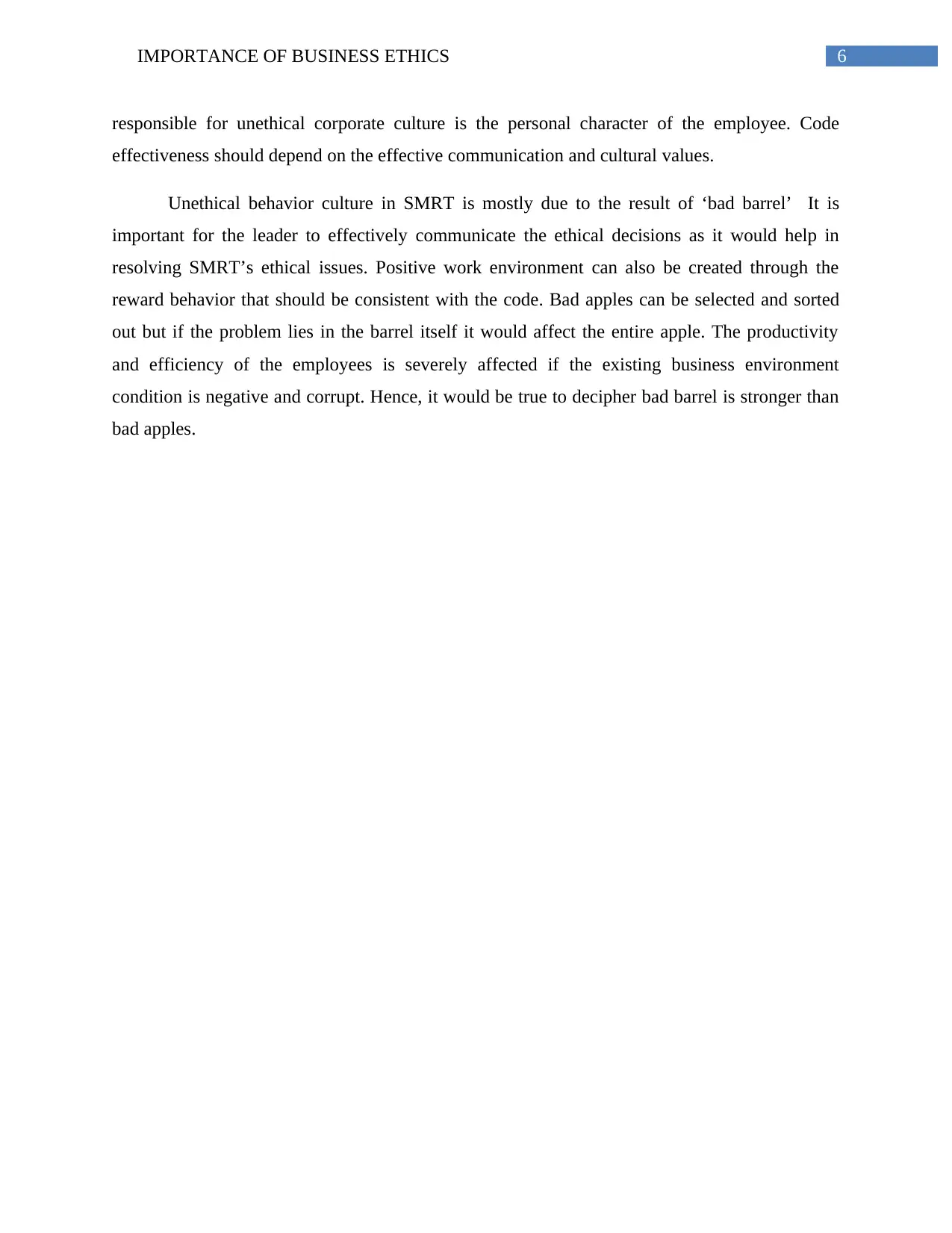
6IMPORTANCE OF BUSINESS ETHICS
responsible for unethical corporate culture is the personal character of the employee. Code
effectiveness should depend on the effective communication and cultural values.
Unethical behavior culture in SMRT is mostly due to the result of ‘bad barrel’ It is
important for the leader to effectively communicate the ethical decisions as it would help in
resolving SMRT’s ethical issues. Positive work environment can also be created through the
reward behavior that should be consistent with the code. Bad apples can be selected and sorted
out but if the problem lies in the barrel itself it would affect the entire apple. The productivity
and efficiency of the employees is severely affected if the existing business environment
condition is negative and corrupt. Hence, it would be true to decipher bad barrel is stronger than
bad apples.
responsible for unethical corporate culture is the personal character of the employee. Code
effectiveness should depend on the effective communication and cultural values.
Unethical behavior culture in SMRT is mostly due to the result of ‘bad barrel’ It is
important for the leader to effectively communicate the ethical decisions as it would help in
resolving SMRT’s ethical issues. Positive work environment can also be created through the
reward behavior that should be consistent with the code. Bad apples can be selected and sorted
out but if the problem lies in the barrel itself it would affect the entire apple. The productivity
and efficiency of the employees is severely affected if the existing business environment
condition is negative and corrupt. Hence, it would be true to decipher bad barrel is stronger than
bad apples.
Paraphrase This Document
Need a fresh take? Get an instant paraphrase of this document with our AI Paraphraser
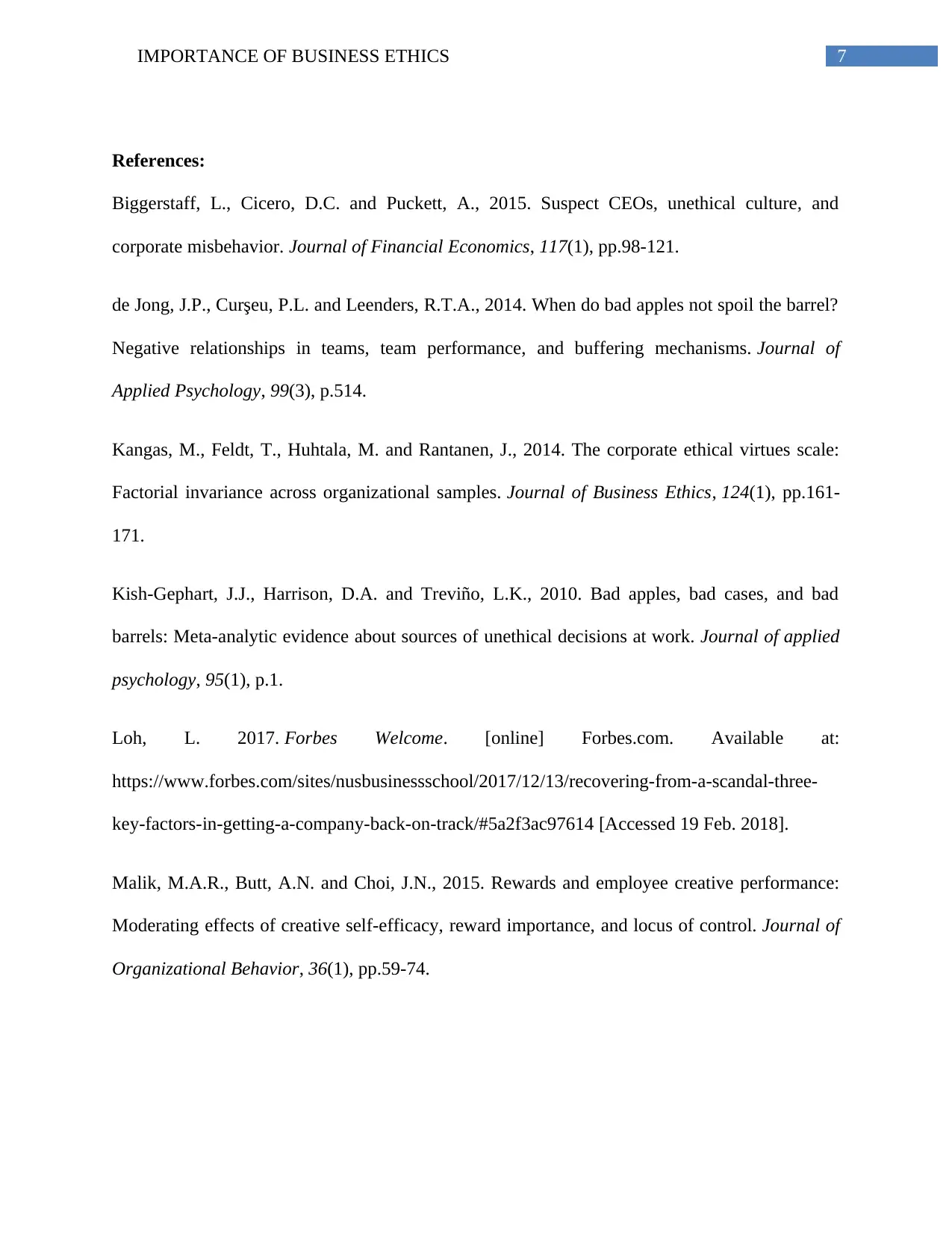
7IMPORTANCE OF BUSINESS ETHICS
References:
Biggerstaff, L., Cicero, D.C. and Puckett, A., 2015. Suspect CEOs, unethical culture, and
corporate misbehavior. Journal of Financial Economics, 117(1), pp.98-121.
de Jong, J.P., Curşeu, P.L. and Leenders, R.T.A., 2014. When do bad apples not spoil the barrel?
Negative relationships in teams, team performance, and buffering mechanisms. Journal of
Applied Psychology, 99(3), p.514.
Kangas, M., Feldt, T., Huhtala, M. and Rantanen, J., 2014. The corporate ethical virtues scale:
Factorial invariance across organizational samples. Journal of Business Ethics, 124(1), pp.161-
171.
Kish-Gephart, J.J., Harrison, D.A. and Treviño, L.K., 2010. Bad apples, bad cases, and bad
barrels: Meta-analytic evidence about sources of unethical decisions at work. Journal of applied
psychology, 95(1), p.1.
Loh, L. 2017. Forbes Welcome. [online] Forbes.com. Available at:
https://www.forbes.com/sites/nusbusinessschool/2017/12/13/recovering-from-a-scandal-three-
key-factors-in-getting-a-company-back-on-track/#5a2f3ac97614 [Accessed 19 Feb. 2018].
Malik, M.A.R., Butt, A.N. and Choi, J.N., 2015. Rewards and employee creative performance:
Moderating effects of creative self‐efficacy, reward importance, and locus of control. Journal of
Organizational Behavior, 36(1), pp.59-74.
References:
Biggerstaff, L., Cicero, D.C. and Puckett, A., 2015. Suspect CEOs, unethical culture, and
corporate misbehavior. Journal of Financial Economics, 117(1), pp.98-121.
de Jong, J.P., Curşeu, P.L. and Leenders, R.T.A., 2014. When do bad apples not spoil the barrel?
Negative relationships in teams, team performance, and buffering mechanisms. Journal of
Applied Psychology, 99(3), p.514.
Kangas, M., Feldt, T., Huhtala, M. and Rantanen, J., 2014. The corporate ethical virtues scale:
Factorial invariance across organizational samples. Journal of Business Ethics, 124(1), pp.161-
171.
Kish-Gephart, J.J., Harrison, D.A. and Treviño, L.K., 2010. Bad apples, bad cases, and bad
barrels: Meta-analytic evidence about sources of unethical decisions at work. Journal of applied
psychology, 95(1), p.1.
Loh, L. 2017. Forbes Welcome. [online] Forbes.com. Available at:
https://www.forbes.com/sites/nusbusinessschool/2017/12/13/recovering-from-a-scandal-three-
key-factors-in-getting-a-company-back-on-track/#5a2f3ac97614 [Accessed 19 Feb. 2018].
Malik, M.A.R., Butt, A.N. and Choi, J.N., 2015. Rewards and employee creative performance:
Moderating effects of creative self‐efficacy, reward importance, and locus of control. Journal of
Organizational Behavior, 36(1), pp.59-74.
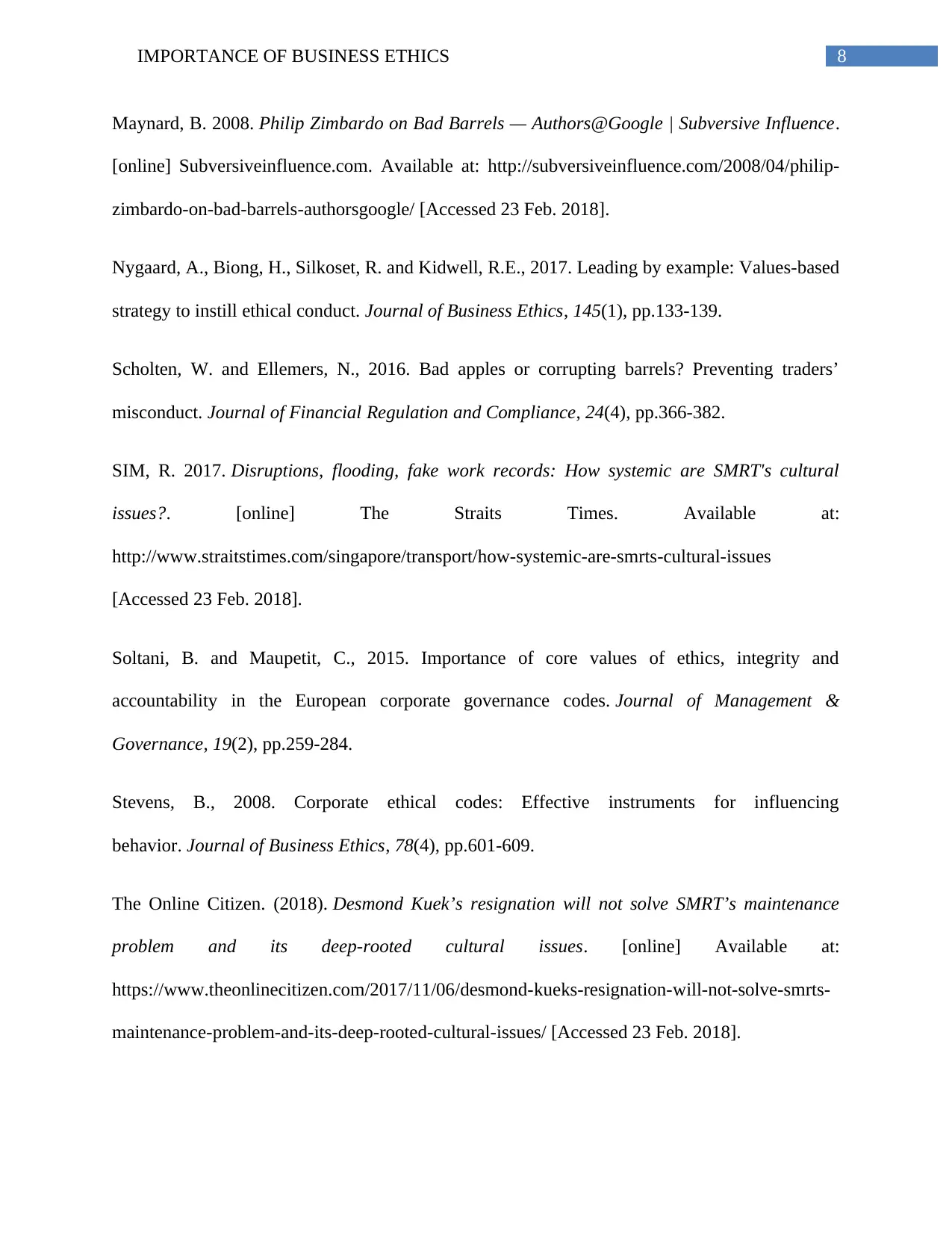
8IMPORTANCE OF BUSINESS ETHICS
Maynard, B. 2008. Philip Zimbardo on Bad Barrels — Authors@Google | Subversive Influence.
[online] Subversiveinfluence.com. Available at: http://subversiveinfluence.com/2008/04/philip-
zimbardo-on-bad-barrels-authorsgoogle/ [Accessed 23 Feb. 2018].
Nygaard, A., Biong, H., Silkoset, R. and Kidwell, R.E., 2017. Leading by example: Values-based
strategy to instill ethical conduct. Journal of Business Ethics, 145(1), pp.133-139.
Scholten, W. and Ellemers, N., 2016. Bad apples or corrupting barrels? Preventing traders’
misconduct. Journal of Financial Regulation and Compliance, 24(4), pp.366-382.
SIM, R. 2017. Disruptions, flooding, fake work records: How systemic are SMRT's cultural
issues?. [online] The Straits Times. Available at:
http://www.straitstimes.com/singapore/transport/how-systemic-are-smrts-cultural-issues
[Accessed 23 Feb. 2018].
Soltani, B. and Maupetit, C., 2015. Importance of core values of ethics, integrity and
accountability in the European corporate governance codes. Journal of Management &
Governance, 19(2), pp.259-284.
Stevens, B., 2008. Corporate ethical codes: Effective instruments for influencing
behavior. Journal of Business Ethics, 78(4), pp.601-609.
The Online Citizen. (2018). Desmond Kuek’s resignation will not solve SMRT’s maintenance
problem and its deep-rooted cultural issues. [online] Available at:
https://www.theonlinecitizen.com/2017/11/06/desmond-kueks-resignation-will-not-solve-smrts-
maintenance-problem-and-its-deep-rooted-cultural-issues/ [Accessed 23 Feb. 2018].
Maynard, B. 2008. Philip Zimbardo on Bad Barrels — Authors@Google | Subversive Influence.
[online] Subversiveinfluence.com. Available at: http://subversiveinfluence.com/2008/04/philip-
zimbardo-on-bad-barrels-authorsgoogle/ [Accessed 23 Feb. 2018].
Nygaard, A., Biong, H., Silkoset, R. and Kidwell, R.E., 2017. Leading by example: Values-based
strategy to instill ethical conduct. Journal of Business Ethics, 145(1), pp.133-139.
Scholten, W. and Ellemers, N., 2016. Bad apples or corrupting barrels? Preventing traders’
misconduct. Journal of Financial Regulation and Compliance, 24(4), pp.366-382.
SIM, R. 2017. Disruptions, flooding, fake work records: How systemic are SMRT's cultural
issues?. [online] The Straits Times. Available at:
http://www.straitstimes.com/singapore/transport/how-systemic-are-smrts-cultural-issues
[Accessed 23 Feb. 2018].
Soltani, B. and Maupetit, C., 2015. Importance of core values of ethics, integrity and
accountability in the European corporate governance codes. Journal of Management &
Governance, 19(2), pp.259-284.
Stevens, B., 2008. Corporate ethical codes: Effective instruments for influencing
behavior. Journal of Business Ethics, 78(4), pp.601-609.
The Online Citizen. (2018). Desmond Kuek’s resignation will not solve SMRT’s maintenance
problem and its deep-rooted cultural issues. [online] Available at:
https://www.theonlinecitizen.com/2017/11/06/desmond-kueks-resignation-will-not-solve-smrts-
maintenance-problem-and-its-deep-rooted-cultural-issues/ [Accessed 23 Feb. 2018].
⊘ This is a preview!⊘
Do you want full access?
Subscribe today to unlock all pages.

Trusted by 1+ million students worldwide
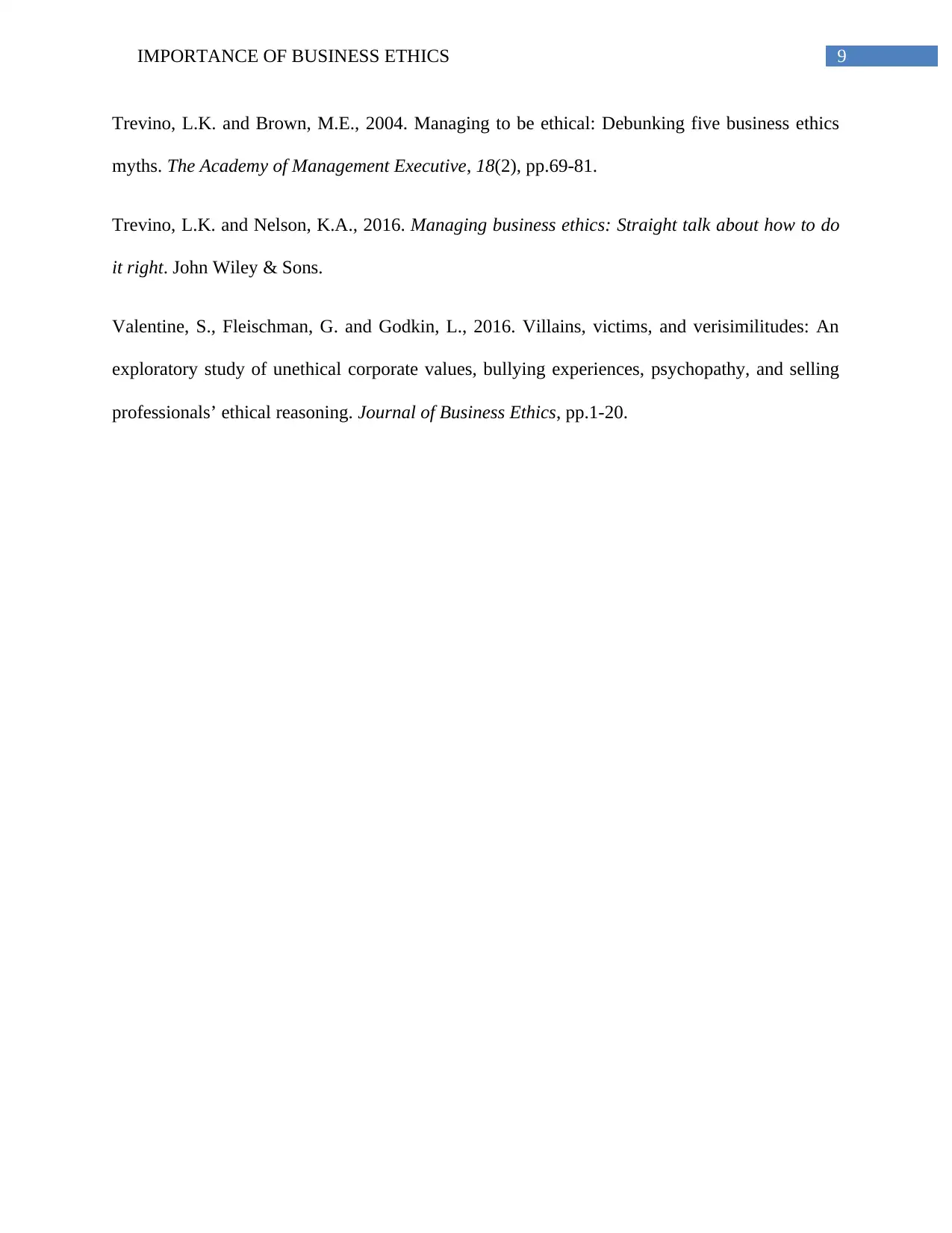
9IMPORTANCE OF BUSINESS ETHICS
Trevino, L.K. and Brown, M.E., 2004. Managing to be ethical: Debunking five business ethics
myths. The Academy of Management Executive, 18(2), pp.69-81.
Trevino, L.K. and Nelson, K.A., 2016. Managing business ethics: Straight talk about how to do
it right. John Wiley & Sons.
Valentine, S., Fleischman, G. and Godkin, L., 2016. Villains, victims, and verisimilitudes: An
exploratory study of unethical corporate values, bullying experiences, psychopathy, and selling
professionals’ ethical reasoning. Journal of Business Ethics, pp.1-20.
Trevino, L.K. and Brown, M.E., 2004. Managing to be ethical: Debunking five business ethics
myths. The Academy of Management Executive, 18(2), pp.69-81.
Trevino, L.K. and Nelson, K.A., 2016. Managing business ethics: Straight talk about how to do
it right. John Wiley & Sons.
Valentine, S., Fleischman, G. and Godkin, L., 2016. Villains, victims, and verisimilitudes: An
exploratory study of unethical corporate values, bullying experiences, psychopathy, and selling
professionals’ ethical reasoning. Journal of Business Ethics, pp.1-20.
Paraphrase This Document
Need a fresh take? Get an instant paraphrase of this document with our AI Paraphraser
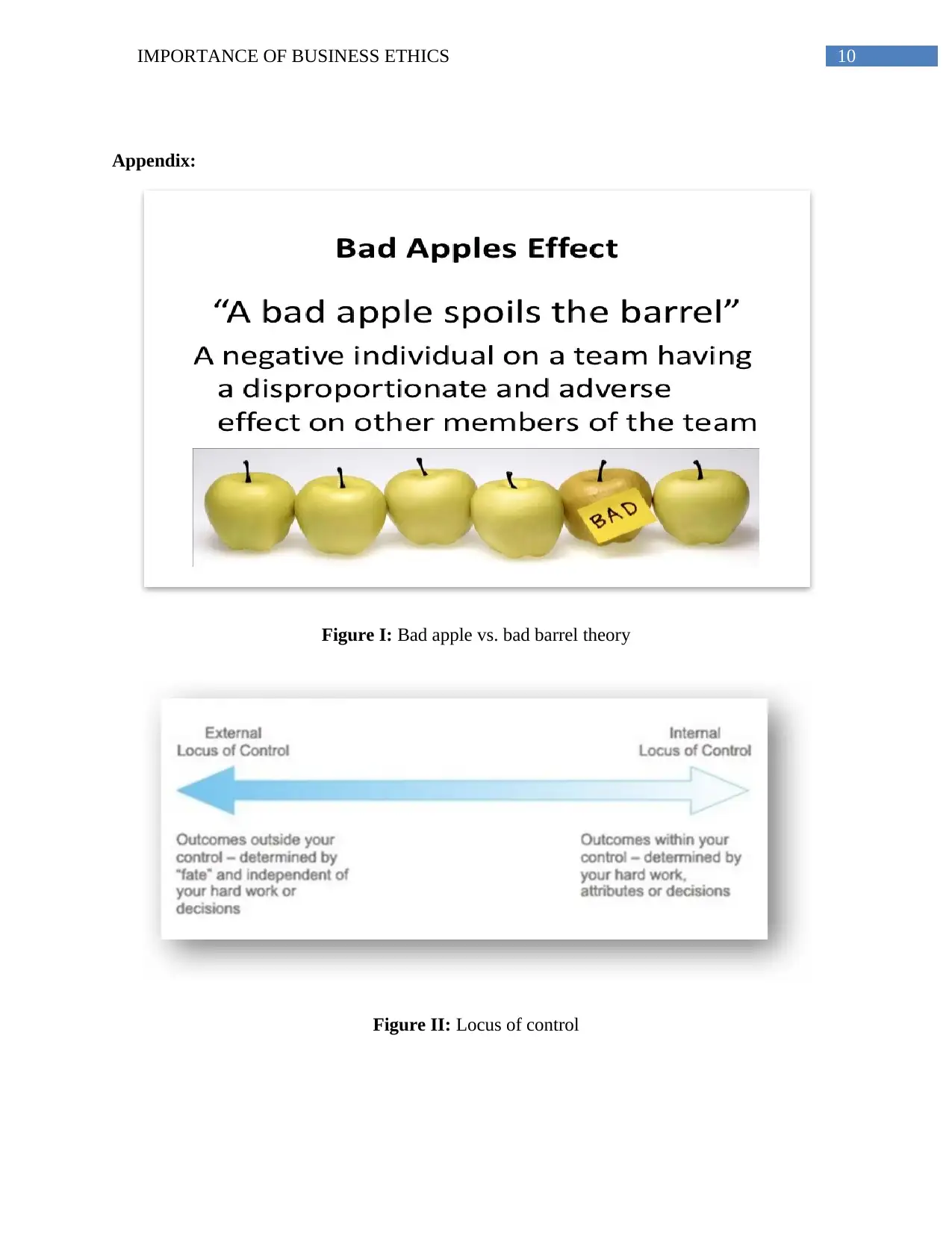
10IMPORTANCE OF BUSINESS ETHICS
Appendix:
Figure I: Bad apple vs. bad barrel theory
Figure II: Locus of control
Appendix:
Figure I: Bad apple vs. bad barrel theory
Figure II: Locus of control
1 out of 11
Related Documents
Your All-in-One AI-Powered Toolkit for Academic Success.
+13062052269
info@desklib.com
Available 24*7 on WhatsApp / Email
![[object Object]](/_next/static/media/star-bottom.7253800d.svg)
Unlock your academic potential
Copyright © 2020–2025 A2Z Services. All Rights Reserved. Developed and managed by ZUCOL.
![Challenges in Leading Change Report - [Course Name] - [Semester]](/_next/image/?url=https%3A%2F%2Fdesklib.com%2Fmedia%2Fimages%2Foo%2F7cab551517d94039bbdbe71a7d40aa97.jpg&w=256&q=75)




